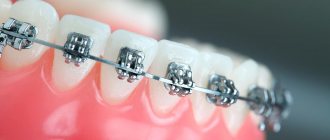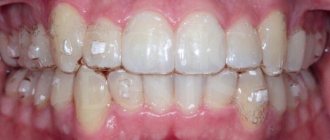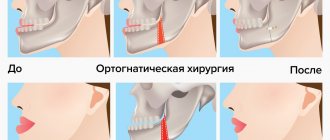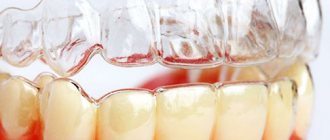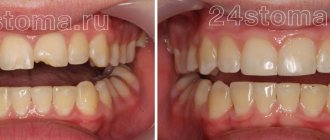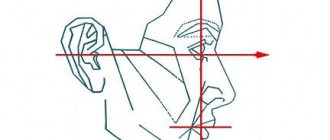926
The first sports mouth guard was developed to protect boxers. Several people who worked on it simultaneously at the end of the 19th and beginning of the 20th century lay claim to the laurels of its inventor.
However, the “father” of sports mouthguards is considered to be the American Liliquist, who in 1948 in the ADA magazine described the technology for making a structure made of acrylic.
Today it is recommended to use mouth guards in 29 sports. In some of them - boxing, American football, combat sports, etc. - the use of intraoral protection is mandatory.
Mouth guards as an alternative to braces
Straightening crooked teeth, of course, should be done in childhood. However, many parents simply do not pay attention to this problem. Therefore, the question of orthodontic treatment for most patients arises in adolescence or adulthood. However, not every teenager or adult will agree to put braces on their teeth and follow not the most simple rules of hygiene. Until recently, there was no alternative to braces. But with the advent of aligners - mouth guards for straightening teeth, it became possible to undergo orthodontic treatment unnoticed by others and with comfort for yourself. Moreover, this applies not only to adults, but also to teenagers, for whom their own technology of transparent mouth guards has been developed. Like aligners for adults, they are a set of removable aligners, completely invisible to others, which can correct most dental anomalies, provided that the attending physician has the appropriate experience.
Types of mouth guards
In dentistry, there are many criteria by which aligners are divided into types or types.
By functionality:
- relaxation - for muscular pathologies of the jaw;
- stabilizing - for deviations in the position of the teeth or jaw.
By production method:
- thermoplastic - the mouth guard is made from a special thermoplastic material, which tends to soften under the influence of hot water and hardens in the desired shape on the patient’s teeth;
- individual - aligners made using impressions and a 3D model of the patient’s jaw.
Based on the material, mouthguards are divided into bioplastic and silicone. There are no significant differences between the materials. Both types belong to the bio-category, do not cause allergies, are invisible and not noticeable on the teeth, and are also transparent.
By operating time:
- night - used only at night to eliminate minor defects or after wearing braces to consolidate the results;
- 24-hour - such mouthguards can be used instead of braces for complex pathologies, but their use involves wearing the products all day long throughout the entire treatment.
By age category:
- for children - standard mouthguards of a smaller size, often made from individual impressions;
- for adults - aligners for adults are not so effective, so they are used only for minor defects, or as the final stage after braces.
A-Medic clinic specialists provide an individual approach to each patient. Taking into account all the criteria for choosing mouth guards in dentistry, the orthodontist selects the most optimal model that will help quickly achieve the desired result.
Features of a mouth guard for teeth straightening
Removable aligners for teeth straightening for adults are made from a special transparent material. Today, their range of applications is no different from the capabilities of braces, but treatment with mouth guards is much easier and more enjoyable. The main advantage of the system is that they are not visible, whereas braces, whether sapphire or ceramic, are still visible on the teeth. Of course, there are also lingual invisible braces, which are attached to the teeth from the inside, but they have a fairly long period of adaptation, just like other brace systems. Typically, it takes several weeks for the patient to adapt to braces, during which it will be uncomfortable for the wearer to eat and talk. In addition, braces, like other types of mouth guards, rub the mucous membrane and “scratch” the teeth, which causes some discomfort. But correcting a bite with a mouth guard is as comfortable as possible for patients.
Indications
A dental mouthguard for teeth can be prescribed not only to correct the bite, but also for other pathologies of this nature.
Main indications for wearing orthodontic aligners:
- bite pathologies;
- incorrect arrangement of teeth in relation to the entire row;
- gaps between adjacent teeth.
Minor indications for which aligners are recommended at the discretion of the dentist:
- bruxism;
- deviations in the functionality of the jaw joints;
- violation of jaw muscle tone;
- uneven load between the upper and lower jaws;
- pathological abrasion of teeth.
There are also a number of contraindications for which it is not advisable to use mouth guards. Thus, aligners are not prescribed for impacted teeth, mental disorders and complex forms of defects in the location of the jaws in the facial area. For diseases of the oral cavity or teeth, corrective therapy is carried out only after they have been eliminated (for example, periodontitis or caries).
Transparent mouth guard for teeth straightening and trainers
Dental aligners for straightening teeth are often confused with trainers and retainers, which are worn after braces are removed. Meanwhile, these are completely different orthodontic devices, which have different indications for use and have different effects on the dental system. Trainers are somewhat reminiscent of sports mouthguards to protect teeth from impacts. With their help, it is possible to correct malocclusion and dental position in children from three years of age, which have developed as a result of impaired breathing and swallowing functions, as well as due to numerous childhood bad habits, such as prolonged sucking of a pacifier or bottle. Trainers are particularly effective for treating early stage malocclusions and are therefore mainly suitable for children under 11 years of age. A retainer is usually prescribed to consolidate the results of orthodontic treatment and adjust muscle function in accordance with the bite. It is bulkier than a clear aligner for adults and is made of flexible silicone.
Reviews
The abundance of types of sports mouthguards makes their choice difficult, especially for those users who purchase them for the first time.
If you use/have used thermoplastic or custom mouthguards, please share your impressions of them. Any details may be of interest - ease of wearing, cost, service life, etc. You can leave a comment at the bottom of this page.
If you find an error, please select a piece of text and press Ctrl+Enter.
Tags mouth guards
Did you like the article? stay tuned
Previous article
Modern effective methods for reconstructing crowded teeth
Next article
Pros and cons of installing an implant immediately after tooth extraction
Silicone aligners for teeth straightening
Treatment with clear aligners minimizes the risk of medical error. The fact is that while wearing braces, the dentist takes a very active part and is independently involved in their installation and corrections, and in the process he may make a mistake. As a result, the course of treatment and, as a consequence, its outcome may be disrupted. In addition, during the next correction, there is a risk of “tightening” the ligature, which can cause severe pain and “eversion” of the roots of the teeth. A transparent mouthguard for straightening teeth for adults acts on hard tissues very smoothly and, if the doctor initially correctly calculated the trajectory of teeth movement, cannot disrupt the course of treatment.
Plastic mouth guards for straightening teeth in teenagers
Despite all the advantages of plastic mouthguards, many people consider removable designs inappropriate for teenagers. The biggest concern of orthodontists and parents regarding orthodontic treatment with aligners is that the patient will constantly remove the appliance, and the entire treatment will go down the drain. The fact is that to achieve the desired effect, the structure must be on the teeth for at least 20 - 22 hours a day. Not all adults follow this immutable rule, let alone teenagers. For peace of mind, you can choose removable mouth guards for straightening teeth in teenagers with an indicator that changes color depending on how many hours the patient has been wearing it. If a teenager has worn a mouthguard too little, the indicator will show this.
Night guard for straightening teeth
Imagine that there is a design for correcting your bite, which you only need to wear at night. It does not require any additional care other than simple cleaning once a day. Thus, it does not interfere with work, communication, eating and does not cause discomfort. Intrigued? We hasten to disappoint you. Unfortunately, nothing like this has yet been invented. But it’s hard not to agree that if a night guard existed, it would, without a doubt, be considered the most convenient to use and enjoy overwhelming success. However, correction of dental anomalies is a complex process that involves exposure to teeth over a certain period of time, and wearing aligners for less than 20 hours a day, unfortunately, will not be effective.
However, among the arsenal of orthodontic devices there are still devices that need to be worn only at night. They are called removable retainers and are used to consolidate the results after treatment with braces. The teeth do not immediately “get used” to the new position, so they often strive to return to their original position. Retainers prevent them from doing this and help keep their teeth perfectly straight.
Therapeutic effect when correcting a bite - with braces or aligners
Since veneers are not involved in correcting the bite, the comparison is between braces or aligners. Advantages by position are highlighted in red. Leadership lies with the aligners.
| Therapeutic effect | ALINERS | BRACKETS | VENEERS |
| Treatment speed | 30% faster than braces | 30% slower than aligners | no healing effect |
| Therapeutic effect (bite correction) | Yes | Yes | No |
| How the effect is achieved | simultaneous rotation and displacement in the desired direction due to the tight grip of each tooth | sequential rotation, horizontal/vertical shift | stick on crooked teeth |
| Actual teeth straightening | Yes | Yes | No |
| Risk of developing caries | No | Yes | No |
| Whitening effect | only before or after treatment | only before or after treatment | immediately after installation |
| Possibility of changing the appearance of teeth | No | No | Yes |
| Rehabilitation period (after removal) | retainers are a MANDATORY PROCEDURE | retainers - wearing retaining mouth guards at night MANDATORY PROCEDURE | absent |
| Reversibility of treatment | partially reversible | partially reversible | irreversible changes |
| Possibility of remineralizing therapy, strengthening tooth enamel | Yes | No | No |
Removal, damage to teeth, enamel, oral mucosa. Aligners are the best
| Removal, damage to teeth, enamel, oral mucosa | ALINERS | BRACKETS | VENEERS |
| Wisdom teeth removal | Yes | Yes | not necessary |
| Removing part of tooth enamel | No | No | Yes |
| Separation of teeth before treatment | of necessity | of necessity | Yes |
| Risk of damaging existing teeth | No | yes (enamel) | There is |
| Possibility of injury to the oral mucosa | No | Yes | No |
Installing a mouthguard to straighten teeth
Aligners are much easier to install than braces, and they are also much more comfortable to wear and adjust. This procedure usually takes place in 3 stages.
- Diagnostics.
The doctor examines the patient for contraindications and diseases that must be eliminated before starting treatment. An accurate cast of the jaw is then made, which will serve as the basis for creating the mouthguards. - Manufacturing.
All data - x-ray, tomogram, jaw model - are sent to the company’s laboratory and processed in a special program. After this, a special device produces the required number of aligners to straighten the teeth. - Installation.
A person receives a set of products and recommendations for use. The specialist helps you put on the device, prescribes medications if necessary, and then sets a date for the next appointment. You will have to visit the orthodontist only once every one and a half to two months to monitor changes. The aligners do not require correction; the dentition is corrected by changing the set every two weeks.
Care instructions
The service life depends on the material from which the pad is made, design, intensity of use and, of course, care for it. It is impossible to name the exact operating time, but in general it is believed to be about 3 years.
Proper care can extend the life of the product. It is simple and consists of following a few rules:
- Should only be used when playing sports.
- It should be stored in a special, ventilated (to get rid of odor) container.
- You must refrain from the desire to chew the pliable elastic structure.
- After each use, rinse in running water to remove bacterial deposits.
- Brush occasionally with a toothbrush and toothpaste (some experts recommend doing this after each use).
- Do not expose the polymer product to elevated temperatures or direct sunlight.
- Periodically inspect for damage and bites. If any are found, the device must be replaced.
In general, all the details of caring for mouth guards are outlined in the instructions that come with them.
In the video, a specialist will tell you in more detail about the types of sports mouth guards.
Does a mouthguard help straighten teeth?
The principle of operation of aligners is almost the same as that of braces - moving teeth into the correct position by applying pressure to them, but the impact of aligners is much gentler. An additional advantage is that this orthodontic design does not require correction; alignment occurs by changing sets.
In general, the effectiveness of aligners directly depends on production technology and a correctly drawn up treatment plan. Some manufacturers openly declare that their product can completely replace braces. Other brands correct both complex and simple dental anomalies, but indicate certain restrictions on indications. These details are always listed on the company’s website and, as a rule, are known to orthodontists.
However, there is one significant caveat. Even if you choose a reliable manufacturer and find a good specialist, the procedure will not give the expected result if you wear the product less than 20 hours a day and do not follow the doctor’s recommendations.
How much do teeth straightening trays cost?
Aligner aligners are one of the most expensive methods of bite correction, but their cost is fully justified by the effect and comfort of use. It is important to note that you should not trust manufacturers who immediately name a fixed amount - you can find out the full cost only after an examination and consultation with an orthodontist. Based on the complexity of the problem, the specialist will draw up a treatment plan, which will indicate the number of mouth guards required for this particular case, the frequency of visits to the doctor and additional structures. These criteria determine the final cost of treatment. All manufacturers of aligners must explain in detail to patients what factors affect the price of the product.
Additional doctor visits and procedures
| Additional doctor visits and procedures | ALINERS | BRACKETS | VENEERS |
| Frequency of doctor visits | Once every 4-6 weeks | every 2 weeks | after fixation once 6 months |
| Probability of root canal treatment | low | low | high |
You should most rarely visit a doctor after installing veneers, most often - every two weeks - when installing braces. Aligners are a relatively comfortable visit once every month to a month and a half.
